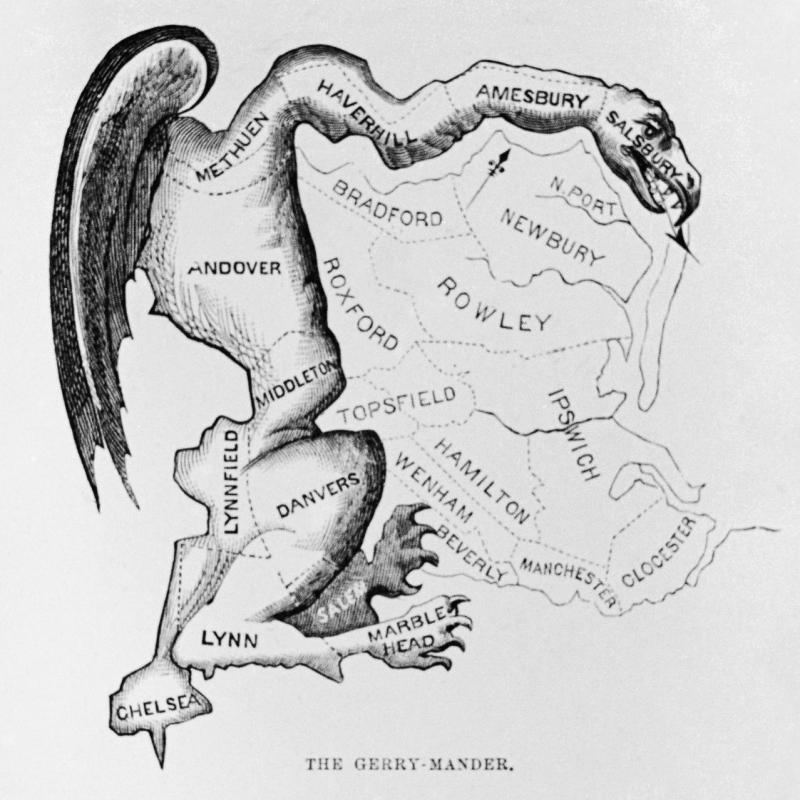'One Person, One Vote' Review: Gerrymander to Win the Game
By: Barton Swaim (WSJ)



Gerrymandering has been an intermittent cause of outrage and argument since long before the word was coined in 1812 to describe the salamander-like Massachusetts state senate district created during the governorship of Elbridge Gerry. The term refers to the centuries-old practice of redrawing the boundaries of political localities in ways that give maximum electoral advantage to one candidate or party against another, but that result in bizarrely shaped districts that carve up communities along seemingly irrational lines. The gerrymander is ugly but unavoidable: Populations migrate, lines must be redrawn, and we have no angels to do the redrawing.
The subject of gerrymandering burst anew into the national consciousness after the election of Donald Trump in 2016. That may appear counterintuitive, presidential elections having nothing to do with redistricting, but Mr. Trump's victory put it into the minds of America's progressive journalists, academics and politicos that Democrats must have been laboring under some terrible and heretofore unseen set of electoral disadvantages. You can understand their panic. What was supposed to be a humiliating defeat for the Republicans somehow turned into a GOP hat trick: victory in the presidential election and retention of both House and Senate. Assorted culprits included the Electoral College, GOP secretaries of state, disinformation on Facebook, collusion with the Russians, the Constitution's malapportionment of Senate constituencies, voter suppression and gerrymandering.
Nick Seabrook has written “One Person, One Vote: A Surprising History of Gerrymandering in America” chiefly to contend that Democrats in the 2020s are losing elections they would win if it weren’t for Republicans’ skill at electoral topiary. He doesn’t put it as directly as that. He insists that the effort to curb gerrymandering is a matter of “democratic best practices” and “good government reform that protects the interests of all citizens.” And he acknowledges that Democrats gerrymander their opponents, too, or at least that they used to do it more effectively than they do now.
But Mr. Seabrook is clearly a man of the left—Republicans who gerrymander do so for nefarious purposes, Democrats do so in the service of “securing justice” for “marginalized communities” and the like—and the book’s overarching argument fits rather snugly with the left’s post-2016 fixation on gerrymandering. The argument is this: After the “reapportionment revolution” of the 1960s, in which a series of Supreme Court rulings required virtually all electoral districts in the country to be apportioned more or less evenly by population, Democrats spent a couple of decades gerrymandering Republicans into retirement. But since the mid-’90s Republicans have learned to use “spreadsheets of census data and sophisticated computerized mapping tools” to gain an unfair advantage.
This, if I could do a little apportioning myself, is about 90% baloney. Democrats in blue states are still quite as skillful at using those “sophisticated computerized mapping tools” to divvy up geographies to their own advantage as Republicans are in red states. The reason the congressional maps of California, Illinois and New York look like Jackson Pollock paintings is raw political calculation.
It’s true that Republicans have gained a modest national advantage in recent decades, but that advantage has nothing to do with data and spreadsheets. It arises from the fact that Democrats prefer to mostly live in large cities, and Republicans mostly do not. For a host of mundane practical reasons, it’s easier to draw lines favoring electors who spread out than it is to carve up densely populated metropolitan areas where people live on top of each other. As long as the American political system accounts for geography in the allocation of political power—you get to vote in this or that election because you live in one place and not another—there’s nothing anybody can do about the slight advantage enjoyed by country over town. Of course, Democrats enjoy advantages of their own—they can count on the support of the news media and the universities and the entertainment industry and federal bureaucracies—and there isn’t anything anybody can do about that, either.
Mr. Seabrook, a professor of political science at the University of North Florida, doesn’t see it that way. “To gerrymander,” he writes, “is to distort, to corrupt, to turn the institutions that should be working on behalf of the people’s interests into perversions that serve only the powerful, the moneyed, or the politically connected. Whenever political machinations over gerrymandering are afoot, no matter who wins, it’s always the voter who loses.”
Gerrymandering is an ugly business, for sure. But it’s no cause for the apocalyptic despondency with which progressive authors like Mr. Seabrook are accustomed to meet every political problem. The politicians and political appointees who create gerrymandered districts—including those nameless spreadsheet-wielding Republican “redistricting operatives,” as Mr. Seabrook calls them—are not the diabolical geniuses their antagonists suppose. How do I know this? Because the information on those spreadsheets comes from the last election, not the next one, and voters have a strong propensity to do things the political class had no idea they would do.
“One Person, One Vote” contains some engaging history, but I’m not sure I’ve ever read a book that includes so much evidence against its own thesis. Maybe this is what the subtitle means by that word “surprising.” A few pages into the introduction, Mr. Seabrook favorably quotes a 2016 assertion by the progressive journalist David Daley to the effect that Republicans, thanks to their skill in gerrymandering, had the American electoral system in its back pocket. “With hindsight,” Mr. Seabrook has to grant, “Daley was of course completely wrong about 2018.” There’s that, yes.
Patrick Henry, as a member of Virginia’s House of Delegates, may have tampered with the U.S. House district for which James Madison ran in 1788 (the evidence is unclear), but it didn’t matter—Madison won handily anyway. (Henry, we’re told, was “constrained by a dearth of data.”) In 1842 Ohio Democrats tried to redistrict their Whig opponents into oblivion but failed to get it done; the election happened under the old districts, and the Democrats still triumphed easily.
In 1961, after New York lost two Congressional seats as a result of the 1960 census, the Republican majority in Albany attempted to use the opportunity to carve a few Democrats out of their seats. It didn’t work. Democrats gained seats in the delegation. “In 1964, LBJ’s coattails carried the Democrats to an improbable victory,” writes Mr. Seabrook. Right—improbable victories happen a lot in politics, and gerrymandering works except when it doesn’t.
Sometimes gerrymandering did work, and thank God it did. In 1858 Abraham Lincoln lost his race for Senate because Illinois Democrats, despite winning fewer votes statewide, had redrawn districts in a way that gave them a slim majority of electors, who chose the incumbent, Stephen A. Douglas. That loss prompted Lincoln to aim for the presidency in 1860, which of course he won. Mr. Seabrook does not seem to appreciate the irony that the United States likely owes its survival to a gerrymander.
The subject of race makes it plain that Mr. Seabrook, like other progressives and the Democratic Party generally, doesn’t know what he wants, other than to attribute bad motives to Republicans. The problem arises from one of the few predictable things about American politics: Black voters overwhelmingly prefer Democrats. GOP map-drawers can’t be expected to ignore this fact any more than Democrats can, but it’s somehow unremarkable when Democrats use it for political ends, and evidence of bigotry and cynicism (Mr. Seabrook relies on both explanations) when Republicans do the same. The Supreme Court has tried over the decades to solve the dilemma presented by black voters’ attachment to one party by recourse to a variety of tests and rules putatively based on the Equal Protection Clause and the Voting Rights Act, but these rulings have bewildered the lower courts and solved nothing.
Mr. Seabrook doesn’t think much of independent redistricting commissions either. He points out—and he is right about this—that commissioners can be influenced and bought off, and that they are as prone to partisan rule-bending as anybody else. If entrusting politicians with redistricting amounts to putting foxes in charge of the henhouse, he writes, independent commissions amount to “sham[ing] the foxes into behaving themselves.”
That leaves the courts. Here Mr. Seabrook is hopelessly confused. He expresses support for the idea that judges should enunciate clear rules of redistricting, but at no point does he say what those rules should be. On the one hand, he alleges that judges are as beholden as everyone else to partisan prejudices. Chief Justice John Roberts’s characterization of the judge’s role as that of an umpire—“Umpires don’t make the rules, they apply them”—Mr. Seabrook derides as a “fiction.” More than once he relates obviously partisan decisions by state and federal courts to rubber-stamp egregiously unfair electoral maps.
On the other hand, he repeatedly criticizes judges for not attempting to sort out disputes over district lines. His bête noire on this subject is the New Deal-era liberal justice Felix Frankfurter, who contended in Colegrove v. Green (1946) that federal courts were ill-advised to entangle themselves in state elections. Frankfurter’s dissent in Baker v. Carr (1962), which declared electoral matters justiciable, was a sign, Mr. Seabrook writes, that the justice had become “embittered, cantankerous, and resentful of a world that had long since passed him by.”
So which is it? Are judges cynical partisans who use the bench for the benefit of their pals in the legislature, or are they impartial experts capable of handing down objective principles by which we may safely arrange our elections?
By the book’s conclusion I was about as confused as all those lower-court judges trying to apply the Supreme Court’s various tests and rules. Mr. Seabrook wants the Supreme Court to settle the matter, but to settle it in only one way, a way he can’t or won’t articulate, and anyway it doesn’t matter because “where significant progress has been made in combating the harms of gerrymandering, it has almost always come from the people, rather than the courts.” Huh?
The gerrymander is an unsavory thing. It is also a permanent one, and well-meaning arguments for its abolition generally end up looking like one of those misshapen districts we’re meant to deplore.
Mr. Swaim is an editorial-page writer for the Journal.









Hands down this is my favorite review. As we speak Marc Elias is suing red states to have their districts modified to benefit democrats. Eric Holder has been quietly working on it since he left the DOJ in disgrace
The book is:
One Person, One Vote: A Surprising History of Gerrymandering in America
By the partisan Nick Seabrook